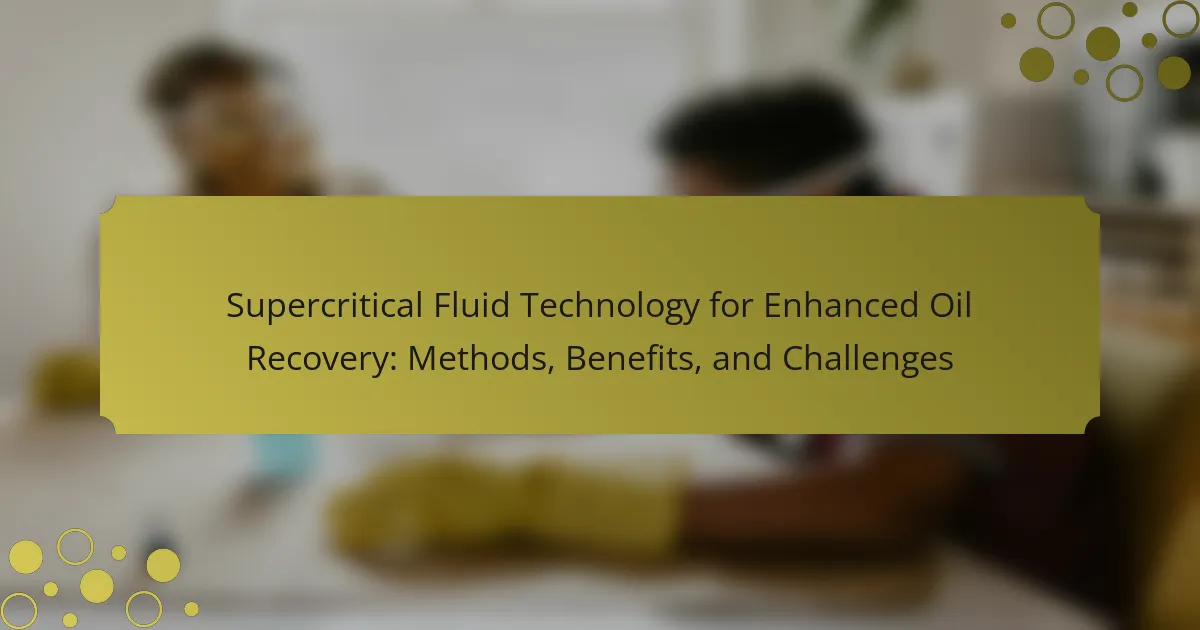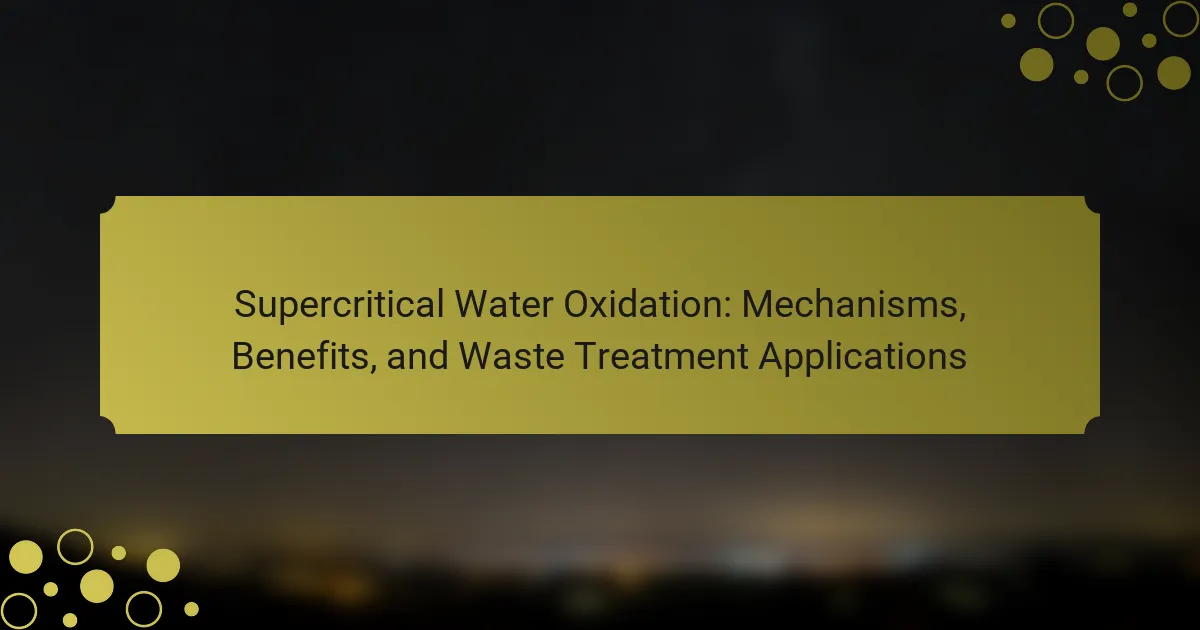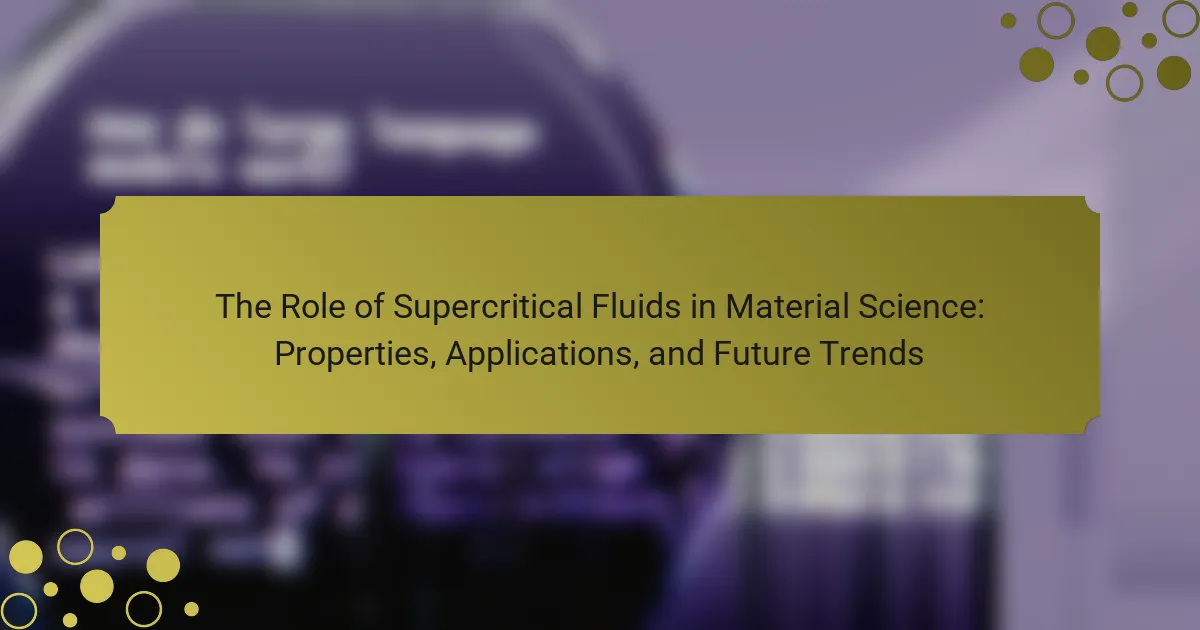Supercritical Fluid Extraction (SFE) is a method for extracting compounds from solid or liquid materials using supercritical fluids, primarily carbon dioxide. This technique combines the properties of gases and liquids, allowing for efficient extraction at lower temperatures, which helps preserve sensitive compounds. SFE is employed across various industries, including food, pharmaceuticals, and cosmetics, and is known for producing higher purity extracts while being environmentally friendly by minimizing the use of organic solvents. The article explores different extraction methods such as static and dynamic extraction, as well as co-solvent extraction, and highlights several case studies demonstrating SFE’s effectiveness in isolating essential oils, caffeine, and carotenoids.

What is Supercritical Fluid Extraction?
Supercritical Fluid Extraction (SFE) is a technique used to extract compounds from solid or liquid materials. It utilizes supercritical fluids, typically carbon dioxide, to dissolve and separate target substances. In this state, the fluid exhibits properties of both a gas and a liquid. This allows for efficient extraction at lower temperatures, preserving sensitive compounds. SFE is widely used in the food, pharmaceutical, and cosmetic industries. Studies indicate that SFE can yield higher purity extracts compared to traditional methods. Additionally, it is environmentally friendly, reducing the need for organic solvents.
How does Supercritical Fluid Extraction work?
Supercritical Fluid Extraction (SFE) utilizes supercritical fluids to extract compounds from solid or liquid matrices. A supercritical fluid is a substance above its critical temperature and pressure, exhibiting properties of both liquids and gases. Commonly, carbon dioxide is used due to its non-toxicity and ability to dissolve a wide range of substances.
In SFE, the supercritical fluid is pumped into a chamber containing the material to be extracted. The fluid permeates the material and dissolves the target compounds. The pressure and temperature can be adjusted to optimize the extraction process. After extraction, the mixture is depressurized, allowing the supercritical fluid to return to a gaseous state, leaving behind the extracted compounds.
Research has shown that SFE is efficient in extracting essential oils, flavors, and phytochemicals. For instance, a study published in the Journal of Supercritical Fluids demonstrated the effectiveness of SFE in isolating antioxidants from plant materials. This method is favored for its ability to produce high-quality extracts without residual solvents.
What are the key components of Supercritical Fluid Extraction?
The key components of Supercritical Fluid Extraction (SFE) are the supercritical fluid, extraction vessel, and separation system. The supercritical fluid, often carbon dioxide, possesses unique properties that enhance solubility. The extraction vessel is where the material is subjected to high pressure and temperature. The separation system collects the extracted compounds. These components work together to optimize extraction efficiency. SFE is known for its ability to extract high-purity compounds without using harmful solvents. This method is widely used in industries such as pharmaceuticals and food processing.
What conditions are required for Supercritical Fluid Extraction?
Supercritical Fluid Extraction (SFE) requires specific conditions to be effective. The key conditions include temperature and pressure adjustments to reach the supercritical state of the solvent, typically carbon dioxide. For CO2, a pressure of 73.8 bar and a temperature of 31.1°C are necessary to achieve supercritical conditions. Under these conditions, CO2 exhibits unique properties that enhance solubility for various compounds. Additionally, the choice of co-solvent, if used, can influence extraction efficiency. The extraction time and flow rate of the supercritical fluid also play crucial roles in optimizing the extraction process. These parameters must be carefully controlled to maximize yield and selectivity in the extraction of targeted compounds.
What are the advantages of using Supercritical Fluid Extraction?
Supercritical Fluid Extraction (SFE) offers several advantages over traditional extraction methods. It utilizes supercritical fluids, typically carbon dioxide, which have unique properties. SFE provides high extraction efficiency, extracting a wide range of compounds effectively. It operates at lower temperatures, preserving heat-sensitive compounds. The process is environmentally friendly, producing minimal waste and using non-toxic solvents. Additionally, SFE allows for selective extraction, targeting specific compounds based on solubility. This method can be easily scaled up for industrial applications. Studies indicate that SFE yields higher quality extracts compared to conventional methods, enhancing the overall product value.
How does Supercritical Fluid Extraction compare to traditional extraction methods?
Supercritical Fluid Extraction (SFE) is more efficient and environmentally friendly than traditional extraction methods. SFE uses supercritical fluids, typically carbon dioxide, to extract compounds. This method operates at lower temperatures, preserving sensitive compounds. Traditional methods often use solvents that may leave residues. SFE results in higher purity extracts due to reduced contamination risk. Additionally, SFE can be easily scaled up for industrial applications. Research indicates that SFE can yield higher extraction rates compared to methods like solvent extraction or steam distillation. This efficiency is supported by studies showing SFE can extract up to 90% of desired compounds in certain applications.
What specific benefits does Supercritical Fluid Extraction provide in natural product isolation?
Supercritical Fluid Extraction (SFE) offers several benefits in natural product isolation. SFE provides high extraction efficiency, allowing for greater yields compared to traditional methods. It operates at lower temperatures, preserving heat-sensitive compounds. This method uses environmentally friendly solvents, often carbon dioxide, reducing chemical waste. SFE enables selective extraction of desired compounds, enhancing product purity. It also allows for rapid processing times, improving overall productivity. The ability to tune extraction parameters offers flexibility for various natural products. These advantages make SFE a preferred choice in the industry for isolating valuable natural compounds.

What methods are used in Supercritical Fluid Extraction?
Supercritical Fluid Extraction (SFE) utilizes various methods to extract compounds. Common methods include static and dynamic extraction. Static extraction involves saturating the sample with the supercritical fluid before extraction begins. Dynamic extraction continuously flows the supercritical fluid through the sample. Another method is co-solvent extraction, which adds a co-solvent to improve solubility. Temperature and pressure adjustments are also critical in optimizing extraction efficiency. These methods enhance the selectivity and yield of desired compounds. Studies have shown that SFE can achieve higher extraction rates compared to traditional methods.
What are the different techniques for Supercritical Fluid Extraction?
The different techniques for Supercritical Fluid Extraction (SFE) include static, dynamic, and countercurrent extraction. Static SFE involves holding the sample and solvent in contact for a specific time. This technique allows for the extraction of compounds without continuous flow. Dynamic SFE uses a continuous flow of supercritical fluid through the sample. This method enhances the extraction efficiency by maintaining a constant solvent movement. Countercurrent extraction involves the supercritical fluid moving in the opposite direction to the sample. This technique maximizes the contact between the solvent and the sample, improving extraction rates. Each technique has its specific applications and benefits based on the nature of the material being extracted.
How do variations in temperature and pressure affect extraction outcomes?
Variations in temperature and pressure significantly affect extraction outcomes in supercritical fluid extraction (SFE). Higher temperatures generally increase the solubility of compounds in the supercritical fluid. This leads to enhanced extraction efficiency. Conversely, higher pressure can improve the density of the supercritical fluid, allowing for better solvation of target compounds.
Research shows that optimal temperature and pressure conditions vary depending on the specific compounds being extracted. For example, a study by McHugh and Krukonis (2013) indicates that adjusting temperature and pressure can maximize yield and selectivity of desired phytochemicals.
In contrast, lower temperatures may reduce extraction rates but preserve heat-sensitive compounds. Thus, careful control of these variables is crucial for achieving desired extraction results.
What solvents are commonly used in Supercritical Fluid Extraction?
Carbon dioxide is the most commonly used solvent in Supercritical Fluid Extraction (SFE). It is favored due to its non-toxic nature and low cost. Other solvents include ethanol and methanol, which are sometimes used for specific applications. Ethanol can enhance the extraction of polar compounds, while methanol may be used for certain target molecules. The choice of solvent impacts the efficiency and selectivity of the extraction process. Research indicates that carbon dioxide effectively extracts essential oils and bioactive compounds. Its ability to be easily removed after extraction adds to its appeal in natural product isolation.
How can Supercritical Fluid Extraction be optimized?
Supercritical Fluid Extraction can be optimized by adjusting various operational parameters. Key parameters include temperature, pressure, and solvent flow rate. Increasing temperature can enhance solubility and extraction efficiency. Higher pressure typically increases the density of the solvent, improving extraction capabilities. Modifying the solvent flow rate impacts the mass transfer rates during extraction. Additionally, using co-solvents can improve the extraction of polar compounds. Optimizing particle size of the material can also enhance extraction efficiency. Studies have shown that fine particle sizes increase surface area, leading to better extraction outcomes.
What factors influence the efficiency of Supercritical Fluid Extraction?
The efficiency of Supercritical Fluid Extraction (SFE) is influenced by several key factors. These factors include temperature, pressure, and the nature of the solvent used. Higher temperatures generally increase the solubility of the target compounds in the supercritical fluid. Increased pressure enhances the density of the supercritical fluid, improving extraction efficiency. The choice of solvent significantly affects the extraction process, as different solvents have varying affinities for specific compounds. Additionally, the extraction time and particle size of the material being processed play crucial roles in determining the overall efficiency. Studies have shown that optimizing these parameters can lead to improved yields and purity of extracted compounds.
How can the extraction process be tailored for specific natural products?
The extraction process can be tailored for specific natural products by adjusting parameters such as temperature, pressure, and solvent choice. Supercritical fluid extraction (SFE) allows for precise control over these variables. For instance, different natural products may require distinct temperatures to optimize yield and purity.
Pressure adjustments can enhance solubility and selectivity for specific compounds. The choice of solvent, whether carbon dioxide or another fluid, directly influences the extraction efficiency of targeted phytochemicals.
Research shows that tailoring these parameters can significantly improve extraction outcomes. A study by Chemat et al. (2017) highlights how modifying extraction conditions can yield higher concentrations of desired compounds.
These adjustments create a customized extraction process that meets the unique requirements of various natural products.

What are some case studies of Supercritical Fluid Extraction in action?
One case study of Supercritical Fluid Extraction (SFE) involved the extraction of essential oils from rosemary. Researchers utilized SFE to obtain high-quality extracts with enhanced flavor and aroma profiles. The study demonstrated that SFE yielded 30% more oil compared to traditional methods. Another case study focused on the extraction of caffeine from coffee beans using SFE. This method produced a purer extract with fewer residual solvents. The extraction efficiency was reported to be over 95%. A third case study examined the extraction of carotenoids from paprika. SFE achieved a higher yield of carotenoids while preserving their stability. This method was shown to be more environmentally friendly than conventional extraction techniques. These case studies illustrate the effectiveness of SFE in various applications within natural product isolation.
What successful applications of Supercritical Fluid Extraction exist?
Successful applications of Supercritical Fluid Extraction (SFE) include the extraction of essential oils, flavors, and bioactive compounds. SFE is widely used in the food industry for extracting flavors from spices and herbs. For instance, it is employed to extract caffeine from coffee beans without leaving residues. In the pharmaceutical sector, SFE extracts active ingredients from plant materials efficiently. This method preserves the integrity of heat-sensitive compounds. Additionally, SFE is utilized in the cosmetic industry for extracting natural antioxidants from botanical sources. Its applications extend to environmental analysis, where SFE is used to extract pollutants from soil and water samples. These successful applications highlight SFE’s versatility and efficiency across various industries.
How has Supercritical Fluid Extraction been applied in the food industry?
Supercritical Fluid Extraction (SFE) has been applied in the food industry to extract flavors, essential oils, and bioactive compounds. SFE uses supercritical carbon dioxide as a solvent, which is efficient and environmentally friendly. This method preserves the quality of sensitive compounds better than traditional extraction methods. For instance, SFE is used to obtain natural flavors from fruits and herbs without the use of chemical solvents. Studies show that SFE can extract higher yields of antioxidants from plant materials compared to conventional methods. Additionally, SFE helps in the decaffeination of coffee while retaining its flavor profile. The food industry benefits from SFE’s ability to produce high-purity extracts that meet consumer demand for natural ingredients.
What notable results have been achieved in pharmaceutical applications?
Supercritical fluid extraction (SFE) has achieved notable results in pharmaceutical applications. SFE effectively isolates bioactive compounds from natural sources. This method enhances the yield and purity of essential oils and extracts. For instance, SFE has been used to extract cannabinoids from hemp, resulting in high-quality medicinal products. Studies show that SFE can improve the extraction efficiency of antioxidants from plants. Additionally, SFE minimizes the use of harmful solvents, promoting environmentally friendly practices. Research indicates that SFE-derived compounds exhibit enhanced bioavailability. Overall, SFE significantly contributes to the advancement of pharmaceutical formulations.
What challenges are associated with Supercritical Fluid Extraction?
Supercritical Fluid Extraction (SFE) faces several challenges. High operational costs are a significant barrier. Equipment for SFE requires substantial investment and maintenance. The requirement for precise temperature and pressure control adds complexity. Limited solubility of certain compounds in supercritical fluids can hinder extraction efficiency. Additionally, the scalability of SFE processes can be problematic for large-scale applications. The need for specialized training for operators is also a challenge. These factors can limit the widespread adoption of SFE in various industries.
What are common limitations in the use of Supercritical Fluid Extraction?
Common limitations in the use of Supercritical Fluid Extraction (SFE) include high operational costs and complex equipment requirements. SFE typically requires expensive supercritical fluid systems and high-pressure apparatus. This can limit its accessibility for smaller operations. Additionally, the choice of solvent is restricted to those that can become supercritical, such as carbon dioxide. This may not extract all desired compounds effectively. Furthermore, SFE may not be suitable for thermally sensitive materials due to potential degradation at high temperatures. Lastly, scalability can be a challenge, as processes developed at a small scale may not translate well to larger production volumes.
How can these challenges be addressed in practical applications?
Challenges in supercritical fluid extraction can be addressed through optimization of extraction parameters. Adjusting temperature and pressure can enhance solubility and extraction efficiency. Utilizing co-solvents can improve the extraction of polar compounds. Implementing continuous extraction processes can increase yield and reduce processing time. Regular maintenance of equipment ensures consistent performance and minimizes downtime. Training personnel on best practices enhances operational efficiency. Collaboration with research institutions can lead to innovative solutions for specific challenges. These strategies have been validated in various case studies, demonstrating improved outcomes in natural product isolation.
What best practices should be followed when using Supercritical Fluid Extraction?
Use appropriate solvents for Supercritical Fluid Extraction (SFE) to maximize efficiency. Carbon dioxide is commonly used due to its low toxicity and favorable properties. Maintain optimal pressure and temperature to ensure the solvent remains supercritical. This enhances extraction efficiency. Monitor extraction time to prevent degradation of sensitive compounds. Regularly calibrate equipment for accurate measurements. Implement safety protocols to handle high-pressure systems. Conduct small-scale trials before large-scale extraction to optimize parameters. Document all procedures for reproducibility and quality control.
Supercritical Fluid Extraction (SFE) is a method for isolating compounds from natural products using supercritical fluids, primarily carbon dioxide. This technique offers several advantages, including high extraction efficiency, preservation of sensitive compounds, and environmental friendliness, making it suitable for industries such as food, pharmaceuticals, and cosmetics. The article explores the operational mechanisms of SFE, key components, optimization strategies, and various methods employed, alongside case studies demonstrating its effectiveness in extracting essential oils and bioactive compounds. Additionally, it addresses challenges and best practices associated with SFE, providing a comprehensive overview of its applications and benefits in natural product isolation.



